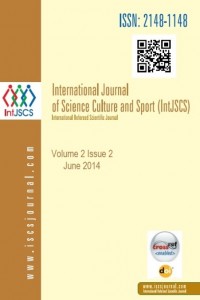PREDICTIVE CONTRIBUTION OF MORPHOLOGICAL CHARACTERISTICS AND MOTOR ABILITIES ON THE RESULT OF RUNNING THE 60m HURDLES IN BOYS AGED 12-13 YEARS
Abstract
The subject of this study is to determine predictive contributions of morphological characteristics and motor abilities on the 60m hurdles, with an aim to form a group of easily applicable field tests so as to identify boys who are talented in hurdle racing. The subject sample of this study was comprised of 60 boys aged 12-13. The variable sample consisted of a 60m hurdles criterion variable and a set of 13 predictor variables comprising of morphological characteristics, speed - strength abilities and the subjects' coordination qualities. Applying the regression analysis, the predictive contribution of a complete variable set of morphological characteristics and motor abilities was determined as an above average statistical significance, influencing 60m hurdle outcome. The greatest individual statistically significant predictive contribution was achieved by the variables of speed-strength quality assessment: 20m flying start race result with a standing long jump; and only one variable from the field of morphological characteristics: the shin length. The results support the following conclusion: the two specific variables of speed-strength quality, and 20m flying start race results along with standing long jump, can be relevant predictors of successful outcome in hurdle races.
References
- Bujak, Z. (2011). Doprinos antropoloških parametara u predikciji pretrčavanja dionice 60M sa preponama (Magistarski rad). Sarajevo: Fakultet sporta i tjelesnog odgoja
- Čoh, M. (1988). Latentne dimenzije odrivne moči. (Doktorska disertacija). Ljubljana: Fakulteta za telesno kulturo Univerze Edvarda Kardelja v Ljubljani.
- Čoh, M. (2003). Biomechanical analysis of Colim Jackson's hurdle Clearance technique.NSA, IAAF, 18:1, 37-45.
- Čoh, M., Bračić, M., Smajlović, N. (2010). Methodical aspects of maximum speed development. Sport Science. (3-2, 11-14).
- Foreman, K. (1989). The use of talent - predictive factors in the selection of track and field athletes. U: The Athletics Congress's Development Committees with Vern Gambeta, Editor, The Athletics Congress's Track and Field Coaching Manual (pp. 31–36). Champaign, Il.: Leisure Press.
- Smajlović, N. (2010). Atletika. Sarajevo: Fakultet sporta i tjelesnog odgojaUniverziteta u Sarajevu.
Abstract
References
- Bujak, Z. (2011). Doprinos antropoloških parametara u predikciji pretrčavanja dionice 60M sa preponama (Magistarski rad). Sarajevo: Fakultet sporta i tjelesnog odgoja
- Čoh, M. (1988). Latentne dimenzije odrivne moči. (Doktorska disertacija). Ljubljana: Fakulteta za telesno kulturo Univerze Edvarda Kardelja v Ljubljani.
- Čoh, M. (2003). Biomechanical analysis of Colim Jackson's hurdle Clearance technique.NSA, IAAF, 18:1, 37-45.
- Čoh, M., Bračić, M., Smajlović, N. (2010). Methodical aspects of maximum speed development. Sport Science. (3-2, 11-14).
- Foreman, K. (1989). The use of talent - predictive factors in the selection of track and field athletes. U: The Athletics Congress's Development Committees with Vern Gambeta, Editor, The Athletics Congress's Track and Field Coaching Manual (pp. 31–36). Champaign, Il.: Leisure Press.
- Smajlović, N. (2010). Atletika. Sarajevo: Fakultet sporta i tjelesnog odgojaUniverziteta u Sarajevu.
Details
| Primary Language | English |
|---|---|
| Authors | |
| Publication Date | February 3, 2015 |
| Published in Issue | Year 2014 Volume 2 - Issue 2 |

